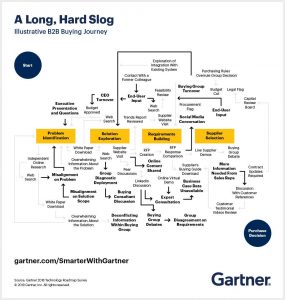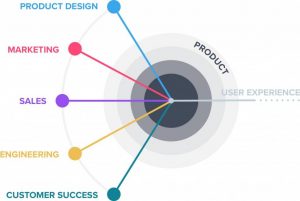Product Led Growth & The New SAAS Buying Committee
January 30th, 2020Topics: Customer Marketing / Sales Products / Services

How do you evaluate enterprise software? A free trial? A sales demo? A Request For Proposal (RFP)? A recommendation?
The answer increasingly depends on another question: who, exactly, are “you?”
For decades, enterprise software was bought and sold in a familiar way. Sales reps targeted senior executives, developed them into champions, internal buying committees debated a business case, and signing a software contract meant a long implementation process aimed at driving employee product adoption from the top down. Even executives who wanted to acquire a tool proactively typically began with a multi-vendor RFP process, with companies competing in part based on whose professional services team could get employees using the product the fastest. Each journey typically ended in the same place: costly implementations and the risk that employees wouldn’t want to use an expensive product in the first place.

Source: Gartner
But enterprise technology hasn’t stood still. The rise of the connected cloud, decrease in the cost of software development, and expanded expectations of end users have fueled a new way of acquiring and serving enterprise software customers: product led growth (PLG).
Coined by expansion–stage venture capital firm OpenView, product led growth is a go-to-market strategy that relies on product usage as the primary driver of customer acquisition and conversion. Fast-growing product led growth-focused SaaS companies like Slack, Zoom, Calendly and Zapier prioritize end user experience, optimize onboarding to remove as much friction as possible, and allow employees within companies to start using their products immediately. PLG strategies enable SaaS companies to acquire end users more efficiently, without relying on executive-focused, top-down sales processes. When an enterprise-wide agreement is needed, sales reps at PLG-focused companies have the advantage of scores of active users already using the product and seeing value within their target accounts. It’s no surprise then that across almost every major performance metric, PLG-focused publicly traded SaaS companies consistently outperform their traditional enterprise software peers.

Image Source: Pendo, What does it mean to be “product led”?
The advantages of product led growth are clear, but the shift towards PLG raises new questions for SaaS buyers and sellers alike. Even as SaaS companies focus on end user experience and employees increasingly adopt enterprise solutions from the ground-up, many organizations still require some form of negotiated enterprise agreement (especially within highly-regulated industries like finance and healthcare) and implementation work for a software tool to reach company-wide scale. Executives used to traditional sales and RFP-driven software buying now have to navigate a world where employees can access valuable enterprise tools on their own.
With this in mind, it’s worth asking: how have the roles and responsibilities within the traditional large enterprise buying and selling “committee” (sales, marketing, customer business leaders, legal/procurement etc.) changed?
SaaS Sellers
Sales: Does a world where a SaaS company’s product drives customer acquisition mean the “end” of sales? Far from it! But the role will change. Rather than driving meetings and demos through cold calls and emails, sales will shift to a more consultative role focused on ensuring target customer end users and executives have the best product experience possible. When a large customer reaches the point where an enterprise-wide agreement makes sense, sales will play a leading role in quarterbacking the process and telling the story of the value an organization’s employees have already experienced using the product.
Customer Success: Customer success managers understand users and their pain points the best and will remain a critical part of the PLG equation. Their jurisdiction and responsibilities, however, are about to expand. Rather than focusing only on select high-dollar customers after a deal has been signed, customer success will play a critical in ensuring that end users at all stages of the customer journey get the most value possible out of a product.
Marketing: In a traditional sales-led model, marketing is measured by its ability to deliver qualified leads to sales. In a PLG model, marketers play a key role in attracting, engaging, and driving the right end users directly to the product. This requires marketers to view the pre-signup customer journey as an extension of the product itself, driving awareness and preparing end users to onboard rather than convincing buyers to schedule a sales meeting or demo.
SaaS Buyers
Business Leaders: Most leaders who’ve purchased enterprise software in the past have felt the pain of long implementation cycles first hand. Even the most thorough vendor diligence process, pilot, or RFP can’t eliminate the risk that a product won’t live up to the value it claims to provide or that employees won’t use it. In a PLG-focused world, executives will have the opportunity to see the tools their employees choose to use and assess their value based on real-world results.
Legal/Procurement: Legal, security, data privacy, and regulatory compliance are critical considerations for any enterprise tool (especially those used in heavily regulated industries like healthcare or finance). PLG companies owe it to end users and their organizations to provide transparency around terms of use, data, and security. At the same time, Legal and Procurement teams have a vested interest in ensuring that employees can access tools that solve business needs with an acceptable level of compliance. Forward-looking Legal and Procurement teams will move proactively to provide clear, actionable guidelines to employees who want to adopt new SaaS products within their teams and update them as needed.
As employees adopt new digital tools to stay productive in an increasingly fast-paced environment and next generation SaaS companies deploy product led growth strategies to serve them, one thing remains clear: those who make enterprise software and those who use it must focus on the end user.
The SaaS companies that win in today’s environment will be those with a deep understanding of the problems faced by end users and the empathy to put user experience first. The enterprises that adapt and arm themselves to thrive in a digital world will be those that acquire digital tools because they make their employees lives better and not because of internal politics or sales pressure.
Whether you’re a SaaS sales rep, marketer, executive or procurement officer, the end user era is here. Whether or not your organization thrives in it is up to you.
Alexander Becker is a first-year student at the Tuck School of Business at Dartmouth College and a Marketing Partner at Dorm Room Fund. Prior to Tuck, Alexander helped grow the Product Marketing team at Catalant and worked as an Associate at Silicon Valley Bank.











